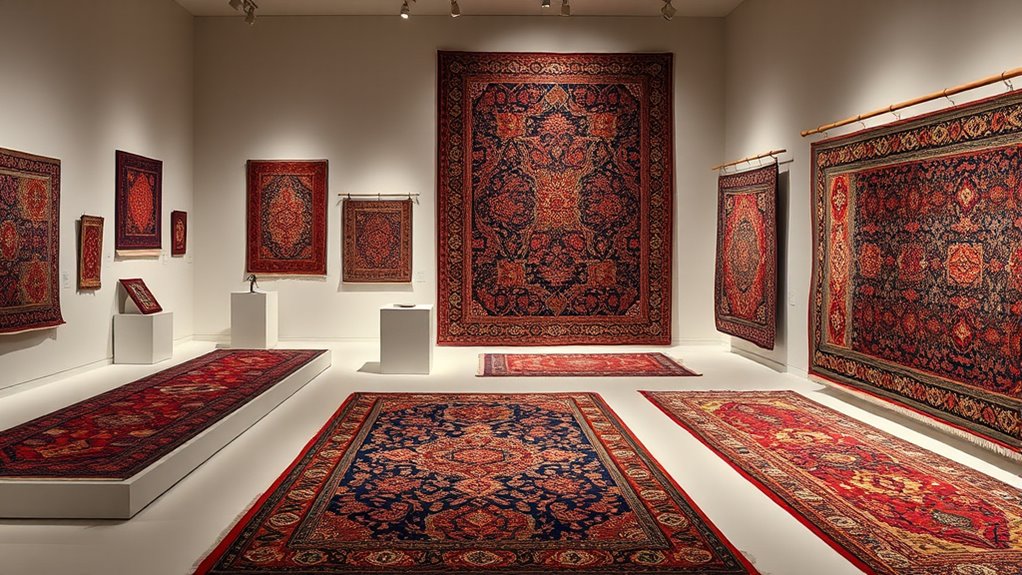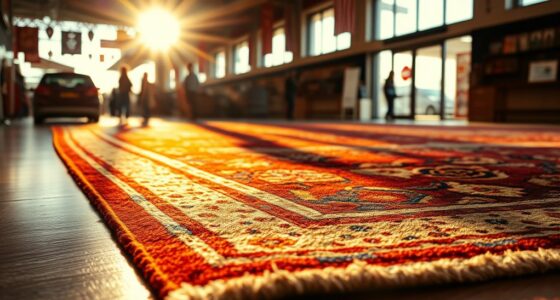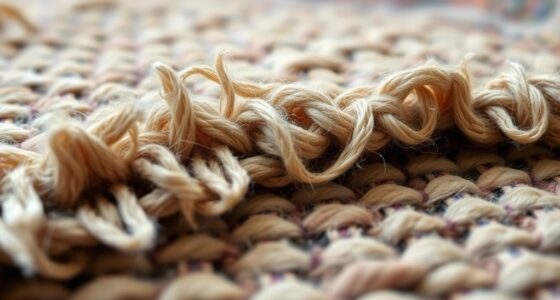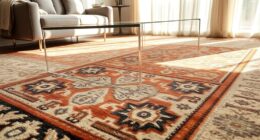To bequeath rugs to museums as part of your estate plan, start by thoroughly appraising and documenting your collection’s cultural significance, provenance, and condition. Choose museums that align with your rugs’ origins and focus, ensuring proper legal and tax procedures are followed. Collaborate with specialists for preservation and appraisal to maximize value. Carefully incorporate the collection into your estate, including clear instructions for donation and display. Continuing with these steps helps secure your legacy and inspire future generations.
Key Takeaways
- Ensure thorough documentation of rug provenance, condition, and cultural significance for accurate valuation and legal transfer.
- Collaborate with textile conservation experts to preserve rug integrity during handling, storage, and display.
- Match rugs with museums whose collections align with their regional, cultural, or artistic importance.
- Complete all legal paperwork, including donation agreements and provenance verification, to ensure proper ownership transfer.
- Consider tax benefits by valuing rugs accurately for charitable deductions, reducing estate taxes, and consulting financial advisors.
Assessing the Cultural and Artistic Value of Your Rugs
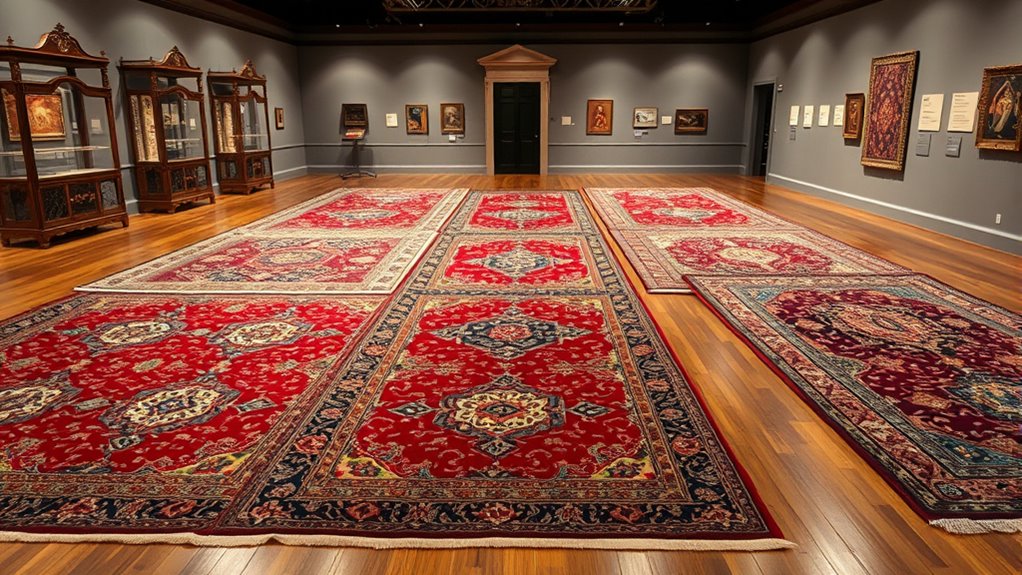
Understanding the cultural and artistic significance of your rugs is essential when appraising their value. You should consider their folklore significance, which reflects the stories, traditions, or symbols embedded in the design. These elements can reveal the region and community that created them, adding to their importance. Additionally, assess their condition through textile conservation practices, ensuring the fibers and dyes remain intact. Rugs with authentic motifs and well-preserved craftsmanship typically hold higher value. Recognizing the cultural context helps you appreciate their heritage and uniqueness. By understanding these aspects, you can better determine their significance, making your appraisal more accurate. This knowledge also informs decisions about preservation, ensuring your rugs retain their historical and artistic integrity for future generations. Moreover, understanding the interconnectedness of individual and collective energy can deepen your appreciation of their cultural roots and significance. Incorporating payment security measures can further protect your valuable collection from potential risks, safeguarding their long-term value. Appreciating the symbolism and storytelling embedded in the designs enhances your overall understanding of their true worth and significance. Additionally, considering building and legal considerations for tiny houses can inspire innovative ways to create dedicated storage or display spaces that respect the cultural value of your collection.
Documenting and Appraising Your Collection
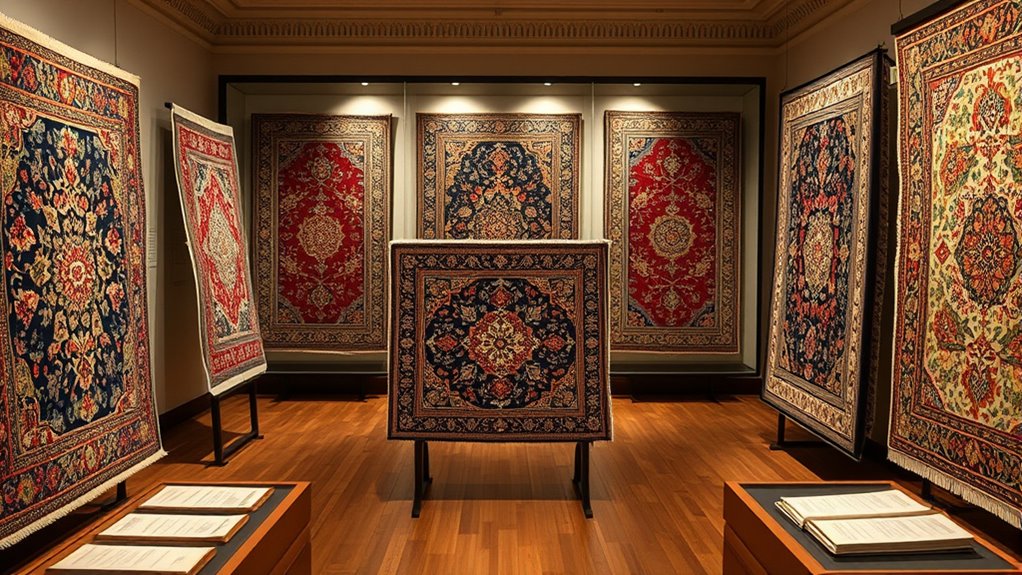
You need to create a detailed catalog of your rug collection, including photographs, descriptions, and provenance. Properly valuing your antique textiles guarantees they’re accurately appraised for estate purposes. Taking these steps now helps protect your collection and simplifies future transfer processes. Additionally, understanding the history of textiles can provide valuable context for appraisal and documentation. Familiarity with AI in Education, such as intelligent tutoring systems, can also assist in creating engaging and comprehensive records for your collection. Incorporating appraisal techniques can further ensure your collection’s value is accurately determined. Research into necessary cookies can help ensure your documentation process remains compliant with privacy standards. Learning about self watering plant pots can offer innovative ideas for preserving fragile textiles by maintaining optimal humidity and storage conditions.
Cataloging Rug Collections
Creating a detailed catalog of your rug collection is essential for both insurance purposes and maintaining its value over time. Start by recording key details like origin, age, size, and condition. Pay close attention to fiber dyeing methods, as natural or synthetic dyes impact authenticity and value. Document weaving techniques, such as knotted, flatweave, or hooked styles, to help identify craftsmanship and regional origin. Include clear photographs from multiple angles, highlighting unique patterns or flaws. Keep notes on any restoration or repairs performed. This thorough documentation ensures you can accurately track changes and preserve provenance. A comprehensive catalog not only aids in appraisal but also simplifies future estate planning, especially when considering bequests to museums or other institutions. Additionally, understanding cookie management policies can ensure your digital records are securely maintained and privacy is protected. Incorporating details about dyeing methods can enhance the authenticity and value assessment of your collection. Moreover, staying informed about AI detection methods can assist in verifying the provenance of digital records or images associated with your collection.
Valuing Antique Textiles
Accurately valuing antique textiles hinges on thorough documentation and expert appraisal. Proper documentation helps preserve the textile’s provenance, history, and condition, which are vital for accurate antique valuation. When appraising, focus on textile preservation techniques that maintain the fabric’s integrity, guaranteeing its value is not compromised. Collaborate with specialists familiar with antique textiles to determine authenticity, age, and rarity. Keep detailed records of any repairs, restorations, or treatments, as these impact value. Professional appraisals provide an objective assessment, essential for estate planning and museum donations. Additionally, understanding textile preservation techniques can help maintain the textile’s condition over time. Staying informed about best practices in textile conservation ensures that your collection remains valuable and well-preserved. Regularly reviewing museum donation guidelines can further streamline the process of bequeathing textiles. By documenting your collection carefully and sourcing expert evaluations, you guarantee your textiles are properly valued, safeguarding their significance and maximizing their worth for future bequests or sale. Incorporating privacy policies can also help you manage sensitive information related to your collection securely. Engaging with conservation professionals can further enhance the longevity and value of your textiles.
Selecting the Appropriate Museum for Donation
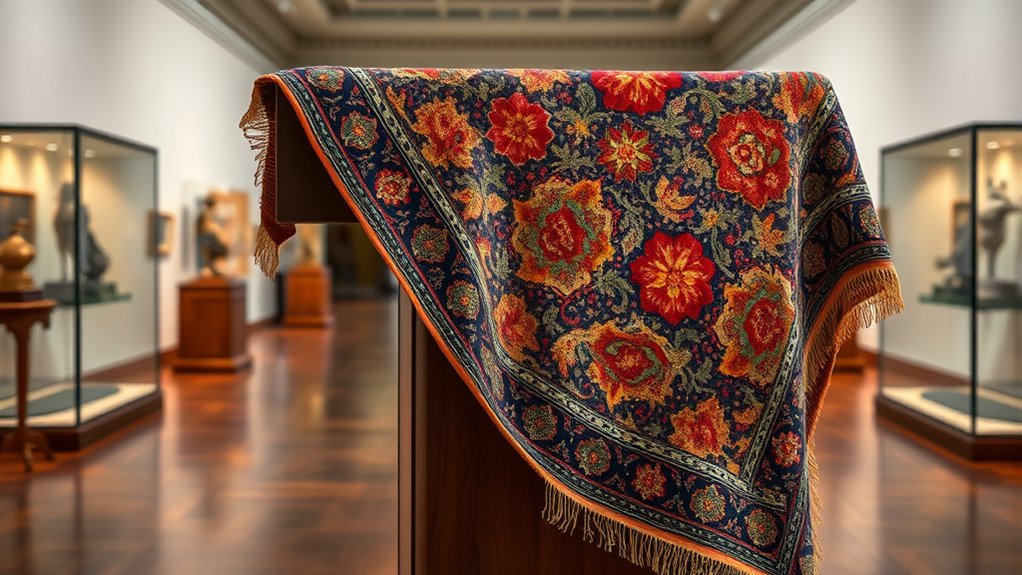
When choosing a museum for your donation, consider their focus and collection to guarantee your items align with their mission. Look into their accessibility and public engagement to see how your donation will be appreciated. Also, verify their provenance and legal requirements to make sure your gift is handled properly.
Museum’s Focus and Collection
Choosing the right museum for your donation begins with understanding its focus and collection. You want to ensure your rugs align with the institution’s mission and enhance their exhibits. Consider the museum’s architecture, which influences how your rugs will be displayed and appreciated. Visitor engagement is also key; a museum that actively involves guests creates a meaningful connection to your donation. Use this table to compare potential institutions:
| Museum Name | Focus Area | Notable Features |
|---|---|---|
| Art & History | Textiles & Decorative Arts | Modern architecture, interactive exhibits |
| Cultural Heritage | Regional Rugs | Historic display spaces, community programs |
| Contemporary Art | Mixed Media & Textiles | Innovative layouts, engaging tours |
| Specialty Museum | Rugs & Textiles | Custom display cases, visitor-centric design |
Match your rugs to a museum that maximizes their impact and aligns with your values.
Accessibility and Public Engagement
Selecting a museum that emphasizes accessibility and public engagement guarantees your donation reaches a broad audience and makes a lasting impact. Look for institutions that offer virtual tours, allowing visitors worldwide to experience your rugs without physical barriers. Accessibility features, such as ramps, audio guides, and braille descriptions, guarantee that everyone can appreciate and learn from your donation. Choosing a museum committed to inclusivity demonstrates your intent to share the beauty and history of your rugs with diverse communities. By prioritizing these aspects, you help expand the museum’s reach and foster greater appreciation for the art. Your thoughtful selection not only preserves your legacy but also ensures your rugs are accessible and engaging for future generations.
Provenance and Legal Considerations
Ensuring your rugs have a clear and legitimate provenance is essential before donating to a museum, as it verifies the item’s history and authenticity. Authenticity verification confirms that your rug is genuine and free from legal issues. When selecting a museum, consider these key factors:
- The museum’s expertise in cultural significance and textile collections
- Its process for authenticating and documenting provenance
- Legal compliance with import/export regulations and ownership rights
Understanding Tax Implications and Benefits
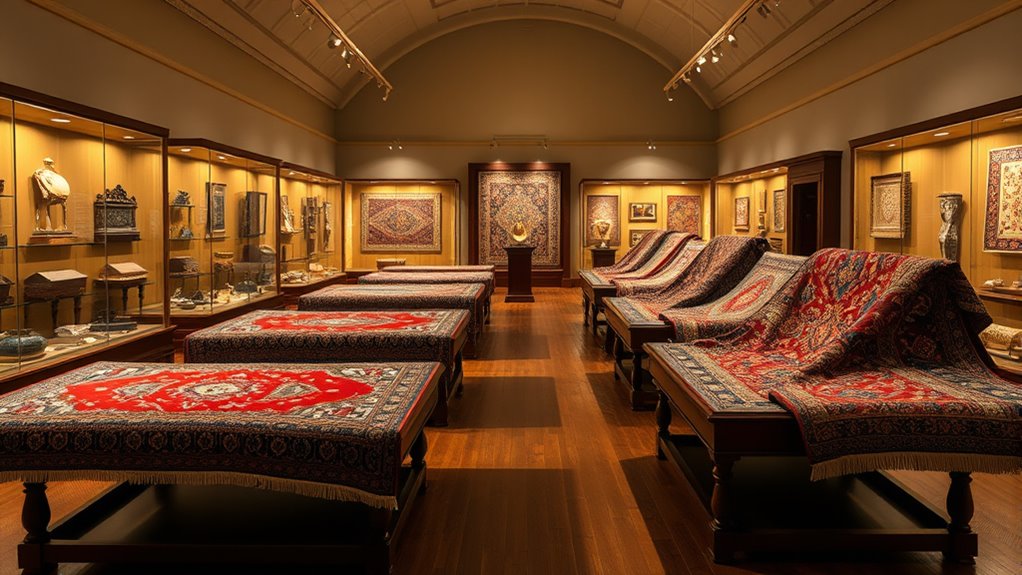
Have you ever wondered how estate planning can help minimize the taxes your heirs will owe? One key benefit is leveraging tax deductions, which reduce the overall estate value subject to estate tax. By properly valuing and donating rugs to museums, you may qualify for a charitable deduction, lowering your estate tax liability. Additionally, gifting valuable rugs during your lifetime can help avoid estate taxes altogether, especially with the annual gift tax exclusion. Understanding these tax implications allows you to maximize your estate’s value for your beneficiaries. Consulting with a financial advisor ensures you’re taking full advantage of available tax benefits and complying with current laws. Proper planning not only preserves your assets but also minimizes the tax burden on your heirs.
Incorporating Rugs Into Your Estate Plan

Incorporating rugs into your estate plan guarantees that these valuable and sentimental items are preserved and allocated according to your wishes. To do this effectively, consider the following:
- Document your rugs’ provenance and significance, emphasizing their cultural and personal value.
- Collaborate with textile conservation experts to ensure proper care and preservation for future generations.
- Include detailed instructions on how you want your rugs to be handled, displayed, or donated, such as through rug weaving techniques or museum curation standards.
Legal Considerations and Donation Procedures
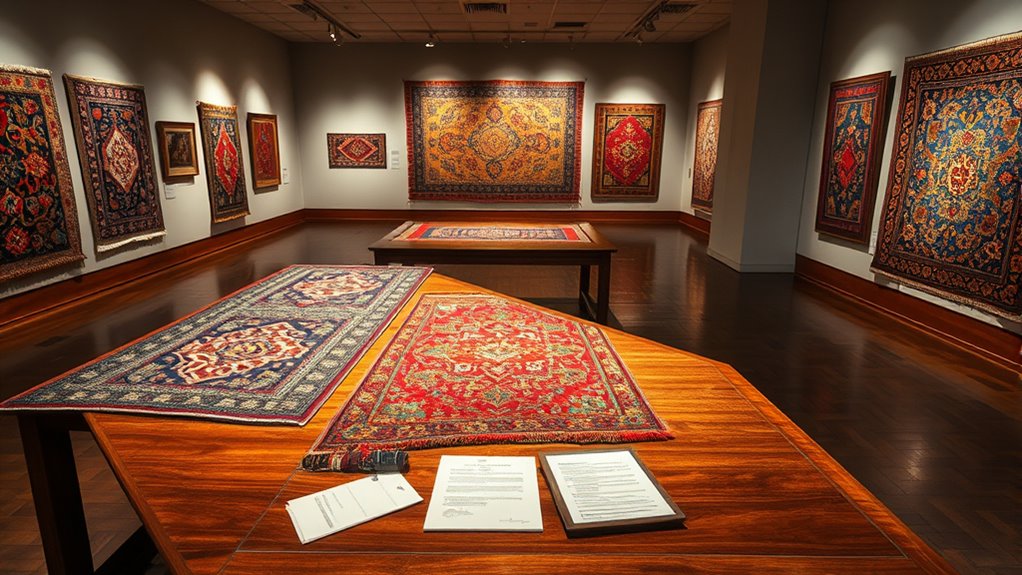
When including rugs in your estate plan, it’s important to understand the legal requirements and proper procedures for donating these items. First, verify you have clear legal documentation, such as a written donation agreement, to establish your intentions and protect your interests. Museums often recognize donors through acknowledgments or recognition programs, so providing accurate information about the rugs’ provenance and condition is essential. Before transferring ownership, confirm that all legal paperwork is complete and properly filed. This process helps avoid delays and ensures your donation is legally valid. Additionally, confirm that the museum’s policies align with your wishes and that they accept the specific types of rugs you’re donating. Following these steps guarantees a smooth donation process and proper recognition for your generosity.
Ensuring Proper Preservation and Display for Future Generations
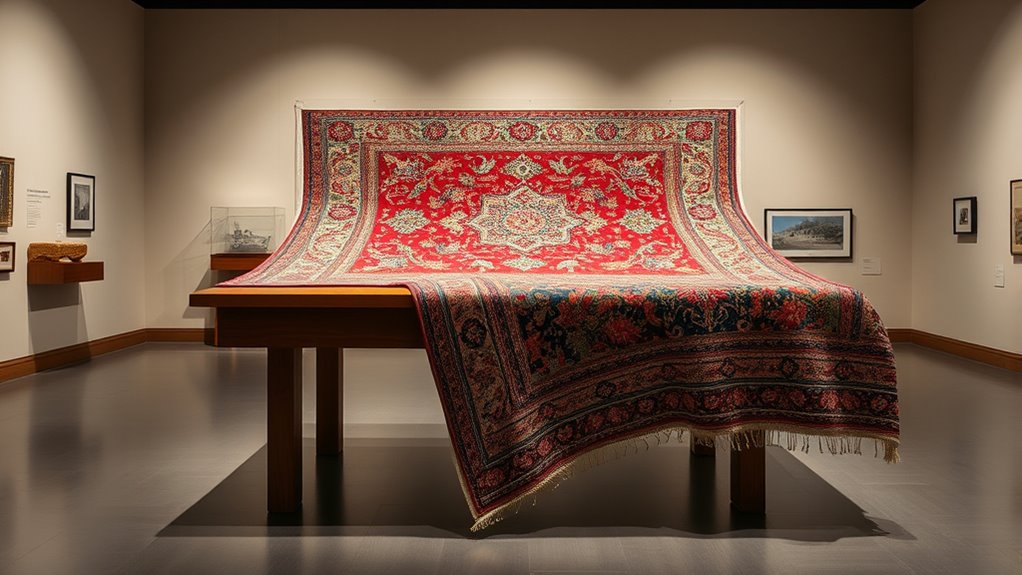
How can you guarantee that your rugs remain vibrant and intact for future generations? Focus on proper textile conservation and understanding rug weaving techniques. First, ensure climate control—maintain stable temperature and humidity levels to prevent deterioration. Second, handle your rugs carefully, avoiding direct sunlight and using gloves to protect fibers. Third, work with specialists in textile conservation when necessary, as they can properly restore and preserve delicate textiles. Proper display methods also matter; use padded mounts or frames that don’t stress the fibers. By combining knowledge of rug weaving with expert conservation practices, you assure your heirloom rugs stay beautiful and durable. This proactive approach helps future generations appreciate your collection’s cultural and artistic significance.
Frequently Asked Questions
How Can I Ensure My Rugs Are Properly Cared for Long-Term?
To guarantee your rugs are properly cared for long-term, focus on rug preservation by storing them in a cool, dry environment away from sunlight. Regular vacuuming and professional cleaning help maintain their condition. Get an antique appraisal to understand their value and specific care needs. Consider consulting a textile conservator for advice on preservation techniques. Proper storage, maintenance, and expert guidance will keep your rugs in excellent shape for years to come.
What Are Common Pitfalls to Avoid When Donating Rugs?
When donating rugs, avoid common pitfalls like overlooking the donation process and valuation procedures. Make certain you understand the museum’s donation requirements and get an accurate appraisal to determine fair market value. Don’t skip documenting your rugs’ provenance or condition, as these details impact eligibility and tax benefits. By carefully steering through the donation process and valuation procedures, you help protect your rugs’ integrity and ensure a smooth, successful gift.
How Do I Choose the Right Museum for My Collection?
When choosing the right museum for your collection, consider their museum partnerships and focus areas to guarantee your rugs align with their mission. Research their donation procedures to understand how they handle donations and whether they appreciate textile collections. Reach out directly to discuss your intentions, and review any policies on displaying or caring for your rugs. This way, you can confidently select a museum that values and properly preserves your collection.
Can I Specify How My Rugs Are Displayed or Used?
It’s a coincidence that your rugs and your desire to influence their display align. You can specify display restrictions and usage preferences in your will or trust, guiding how museums handle your collection. While they usually respect your wishes, it’s wise to communicate directly with the institution and include clear instructions. This way, your rugs are appreciated just as you envision, preserving your legacy for future generations.
What Documentation Is Needed to Confirm My Donation?
To confirm your donation, you need proper documentation, including transfer documentation that proves your gift to the museum. Additionally, an appraisal may be required to establish the value of your rugs for tax purposes. Make sure to keep all receipts, appraisals, and transfer paperwork. This documentation guarantees your donation is properly recorded and compliant with IRS rules, helping you enjoy potential tax benefits while supporting the museum.
Conclusion
Think of your rugs as threads in a rich tapestry, each telling a story that future generations will cherish. By carefully planning your donation, you’re weaving a lasting legacy that preserves art and culture. When you choose the right museum and navigate the legal and tax landscape prudently, your contribution becomes a vibrant stitch in the fabric of history. Ultimately, your thoughtful estate planning guarantees your legacy endures, inspiring others like a timeless, intricate tapestry.
